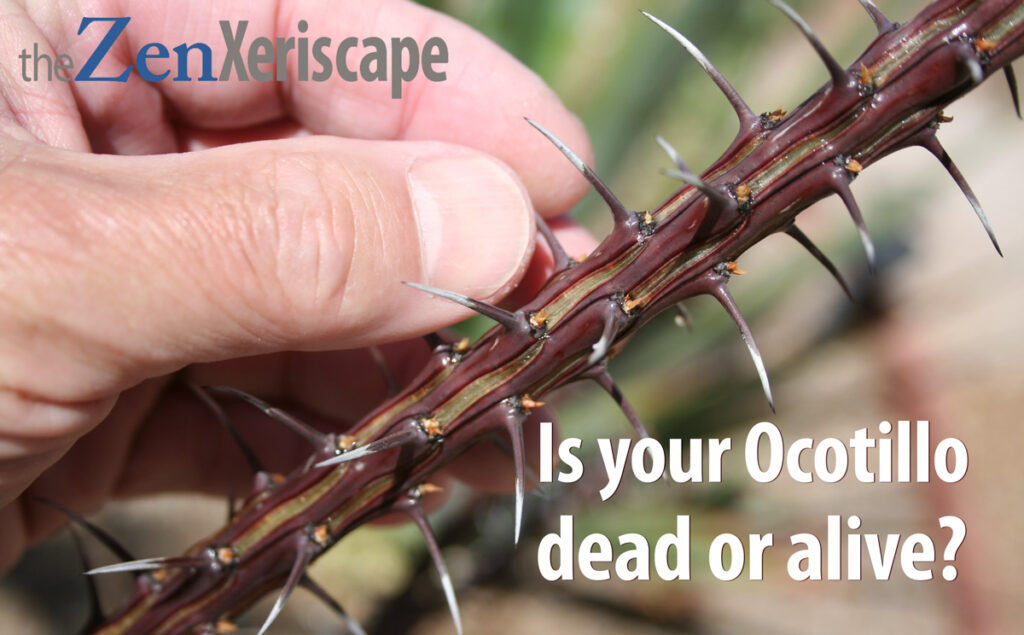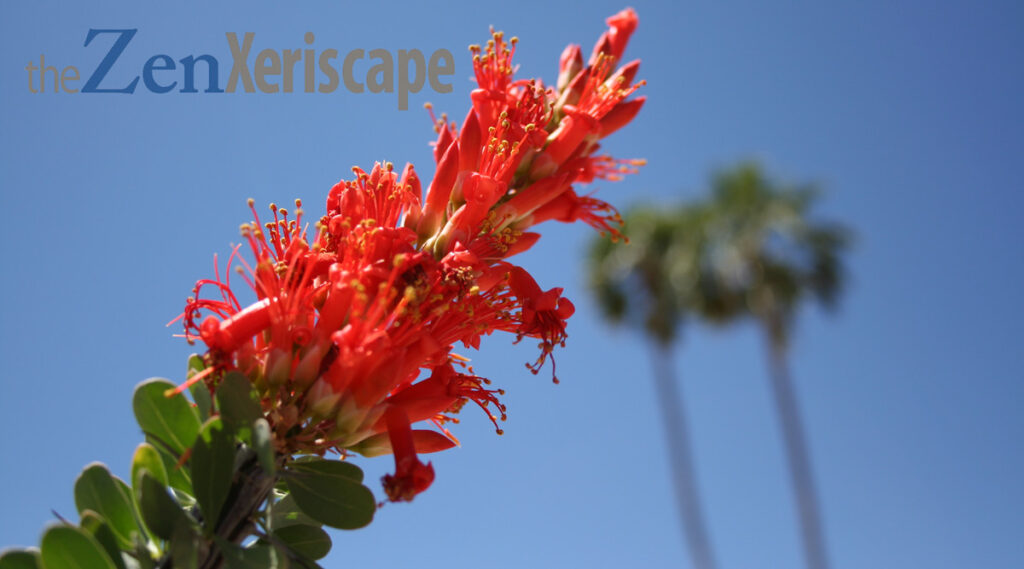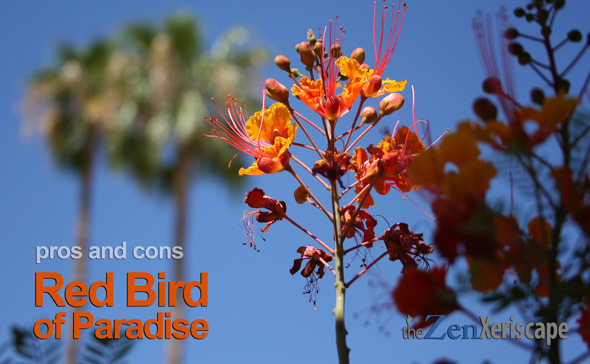
When I first moved to the southwestern United States, I remember how the first ocotillo (Fouquieria splendens) I planted looked dead soon after it was in the ground! I was so disappointed! Months later, my ocotillo looked like a clump of brown, spiny sticks sticks with no leaves and no flowers. Despite those obvious missing signs of life, I didn’t give up hope. I soon learned how to answer this question: “Is your ocotillo dead or alive?”
Is your ocotillo dead or alive?
Without leaves or flowers, any tree, plant or succulent might appear dead. Fortunately the ocotillo can still speak to us even when it appears dead.
Here are some things to look for in your ocotillo:
Ocotillo stems that are alive contain a visible green pigment called chlorophyll
If you look closely at the dead-looking stems or canes of your ocotillo, you should see green bands of chlorophyll (see photo below). Even when this plant has no green leaves, the ocotillo uses chlorophyll in its dead-looking stems to produce energy from photosynthesis!

is to look for the green—an ocotillo
that is still alive has green chlorophyll in its stems.
Photo by Doug Martin
If you’re working with thorny plants like an ocotillo or rose bush, you will need gloves that are thorn-proof. Browse thorn-proof gloves on Amazon! (As an Amazon Associate, I earn a commission from qualifying purchases.)
If you make the stems wet, you should be able to see the green chlorophyll in the stems. In addition, look for developing leaf buds located above each spine.
That’s a clever survival strategy that helps ocotillos survive in their harsh desert environment. So before you give up and trash your dead-looking ocotillo, look for the sometimes subtle green bands of chlorophyll contains in their stems.
Make stems wet to see green chlorophyll
If you look closely at the dry stems, you still might not see hints of a green hue. To make the green more visible, make the stems wet! That’s what I did when I took these photos (see above), and the water really makes the green pigments stand out.
If you see green, then you know your ocotillo is still alive!
Use a knife to scratch the surface
Another way to look for the green, tell-tale sign of life-sustaining chlorophyll in your ocotillo is to scratch the surface with a knife or your finger nail. Underneath the dried bark, you should see fleshy green tissue.
You could also use this technique to look for signs of life in any dead-looking deciduous tree or bush in your xeriscape.
Look for the leaf buds
Another way to confirm life in your ocotillo is to look closely where the sharp spines meet the stem. Just above that point on the stem, you might see new leaf buds that are beginning to emerge. The buds also might already have a nice green hue.
Here in the southwestern United States, new leaf buds appear in the spring, but might also continue to regenerate throughout the summer and fall.
The ocotillo’s buds look very similar to the buds you will see on deciduous trees.

emerging above thorns on the stem.
Photo by Doug Martin
New buds will appear right above the spot where the spines meet the stems.
Buy a beautiful assortment of live succulents on Amazon! (As an Amazon Associate, I earn a commission from qualifying purchases.)
Bend a stem and see if it breaks
If you don’t see strips of green pigment or leaf buds, try bending a stem. If the stem or cane is flexible as you carefully bend it, then it is probably still alive.
On the other hand, if the stem snaps or breaks while you bend it, then it is probably dead. However, one stem might be dead while other stems might still be alive.
If one stem breaks, bend another stem if see if it also breaks. When multiple stems lose their flexibility and break when you bend them, it is probable that your entire ocotillo plant is dead.
Fortunately, if you find that some of your other branches are flexible, your ocotillo still has life in it!
Make the stems wet and water thoroughly, then wait for new leaf buds to appear
Finally, you could thoroughly water your ocotillo (be sure it is planted in well-draining soil). While you water, make the stems wet, also. The moisture on the stems, just like what happens during a desert rain, might stimulate leaf production.
Patience is the key with this last step. After you water the roots thoroughly and make the stems wet, it might take several weeks for new leaves to appear.
Fortunately, if your ocotillo is still alive, it will eventually reward you with luscious green leaves and maybe even some fiery red flowers to usher in the summer heat!

brilliant red flowers.
Photo by Doug Martin
Uniquely beautiful succulents with pots are on Amazon! (As an Amazon Associate, I earn a commission from qualifying purchases.)
TAKEAWAYS:
How to answer this question: is your ocotillo dead or alive?
First, look for a green color throughout the stems. If you see green, then your ocotillo is alive.
Next, look for new leaf buds emerging above thorns. If you see new green leaf buds, then your ocotillo is alive.
Then, you can bend a stem. If the stem is flexible and bends without breaking, then your ocotillo is alive!
Content and photos by Doug Martin and The Zen Xeriscape

Try a Prime Membership today! (As an Amazon Associate, I earn a commission from qualifying purchases.)


